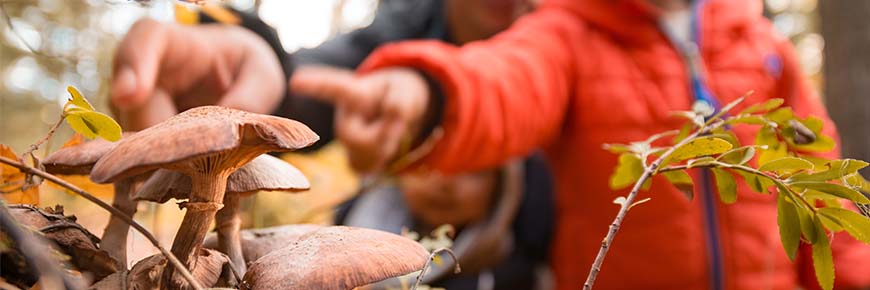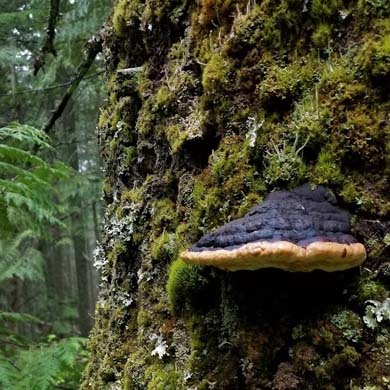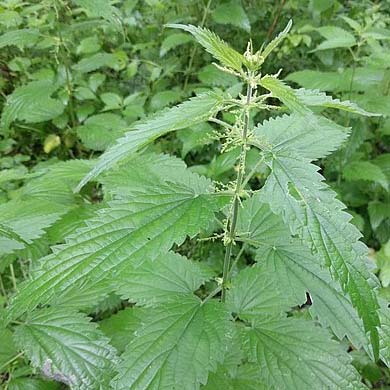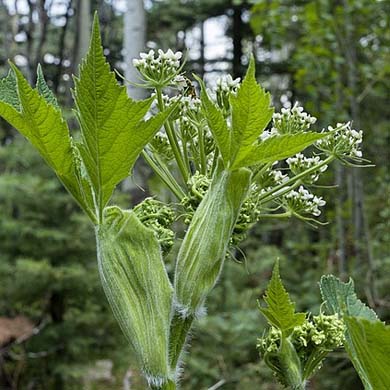
Plants of interest
Mount Revelstoke National Park
The diversity of plants in the interior temperate rainforest, whether on a forested valley bottom trail or high in the alpine, truly capture the imagination. Whatever your age, interests or comfort level in the national parks, there are plenty of plants sure to fascinate the mind! This page captures a small sample of what you can find when you pause and look closely around you.
- Berries bears love
- Only in a moist forest
- Plants with attitude
- In a league of their own
- Plants of the wetland
Berries bears love
Berries are an important food source for many birds and small animals, as well as a critical energy source for black and grizzly bears as they fatten up for their winter rest. Although many berries are safe for people to eat, it is illegal to pick berries in the national parks because so many animals depend on them for survival.
You might find the black huckleberry in open forests, recognizable by a deep blue/purple colour berry and pointy leaf that grows on a low shrub. It is often confused with a blueberry which has oval leaves and chalky blue berries that grow in a similar habitat. Black elderberry can be noticed growing on tall bushes overhead, their leaves have a distinct peanut butter or teriyaki smell when rubbed! The Thimbleberry resembles a softer, squatter and seedier version of a raspberry, growing on waist high bushes with distinctly large, soft leaves. The leaves are known to be a good substitute for toilet paper in a pinch.

Bruno.karklis, CC BY 4.0, via Wikimedia Commons

Edal Anton Lefterov, CC BY-SA 3.0, via Wikimedia Commons

Thayne Tuason, CC BY-SA 4.0, via Wikimedia Commons
Only in a moist forest
In the moist rainforest environment, there is an abundance of fascinating lichen, moss and fungi. You might see Lungwort (also known as lung lichen) lying on the trail after it has blown down from branches above. Lungwort was used by early physicians to treat pneumonia because it resembles our lungs! It is an indicator of good air quality and does not survive where the air is polluted. Bracket fungus grows on dead standing and fallen trees. The fungus spreads within dead trees and helps with decomposition. There are too many mosses to name in the moist forest environment, but one distinct moss is fire moss with its distinct red stalks. It is worth taking the time to stop along the trail, crouch down and capture some close up photos of these alien-looking mosses.

Bernd Haynold, CC BY-SA 3.0, via Wikimedia Commons


Plants with attitude
There are some plants that you do not want to touch due to their defensive nature. Devil’s club can be found towering in old forests with its sharp, strong spines along every surface including the underside of its mammoth leaves. Stinging nettle can grow from 1-3m tall and can look pretty harmless amongst other plants, but you’ll take notice of it if you accidentally brush past it in the forest. It leaves a burning sensation on the skin and produces small itchy bumps as the fine hairs from the plant break and release formic acid, the same acid released by ants. Sundews are a carnivorous plant, but thankfully it is so small that it only feeds on insects that are attracted by its sweet nectar. The glands release a sticky juice that captures insects and then an enzyme to digest the freshly caught meal. It grows in undisturbed bogs or fens on sphagnum moss.


Michel Langeveld, CC BY-SA 4.0, via Wikimedia Commons

Orchi, CC BY-SA 3.0, via Wikimedia Commons
In a league of their own
Wild ginger is common in low elevation forests and has distinct heart shaped, dark green, leathery leaves that grow close to the ground. The entire plant has a distinct lemon-ginger smell and the roots have been used by Indigenous people for stomach ailments and colds. Cow parsnip can grow up to 2 meters in height, depending on its location. It is common from low to high elevation and it is a big food source for both grizzly and black bears. The spotted coralroot orchid is because it is not green like most other plants. It does not photosynthesize and instead gains its energy from a fungus in the ground. Its pretty little flowers are worth stopping for!



Plants of the wetland
Wetland plants are hydrophilic - this means they like growing in wet places. Many are very unique looking plants as they’ve adapted to their watery habitats. Skunk cabbage is one of the first plants to bloom in the spring and plays a role in melting the snow around it. Skunk cabbage is named for its distinct pungent smell, which is much more pleasant than the animal that it is named after. Later in spring, giant leaves emerge that can reach up to a metre in height. There are also many kinds of horsetail plants, and they date back to the time of dinosaurs! Horsetail has also been used by people to scrub pots and to sand wood because it is high in silica. It can actually grow both in water and on dry slopes. Duckweed is another interesting water plant, it appears as a pin-sized bean floating on the water’s surface with its roots hanging below and usually grows in broad mats. Duckweed is aptly named as a favoured food of ducks and other water birds.



Related links
- Date modified :